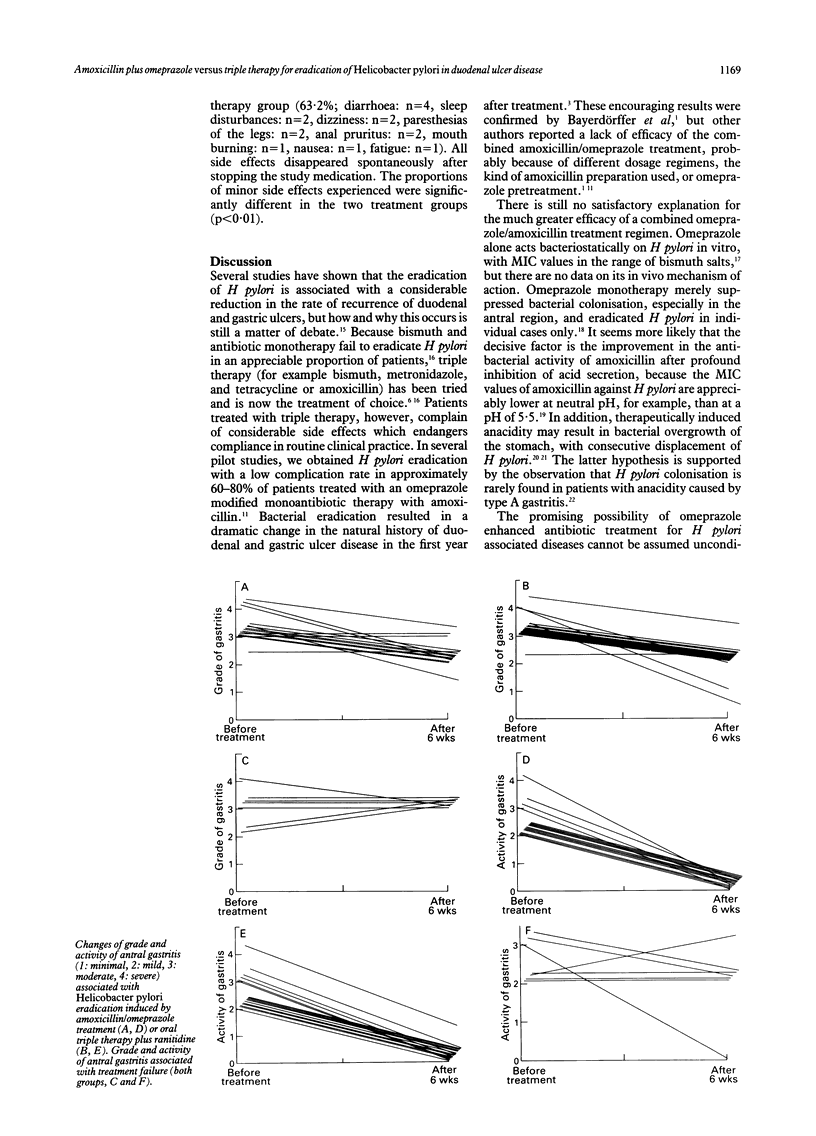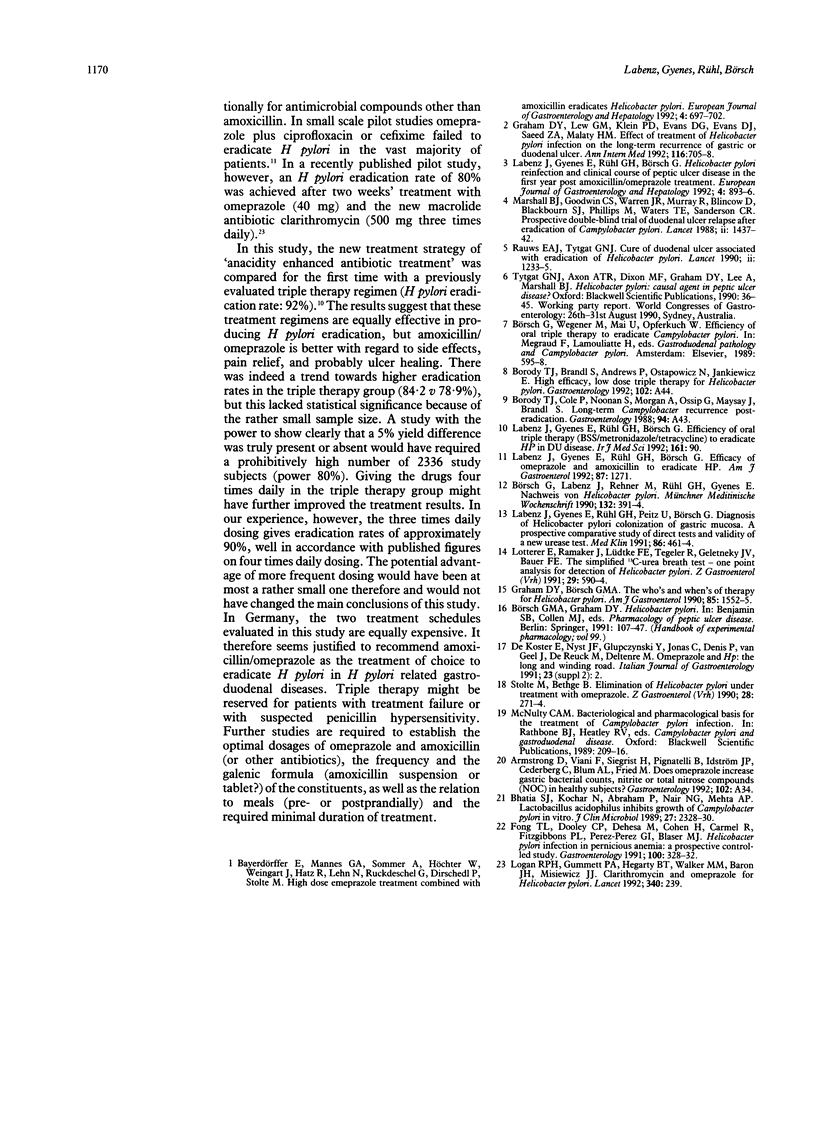Abstract
Treatment with amoxicillin and omeprazole resulted in encouraging Helicobacter pylori eradication rates in pilot studies that included medium term follow up. These results were evaluated in a prospective, randomised and controlled study. Forty patients with active duodenal ulcer disease and H pylori colonisation of the gastric mucosa were randomly assigned to receive either omeprazole (20 mg twice daily) and amoxicillin suspension (500 mg four times daily) for two weeks (group I) or bismuth subsalicylate (600 mg three times daily), metronidazole (400 mg three times daily), tetracycline (500 mg three times daily), and ranitidine (300 mg in the evening) for two weeks (group II). Study medication was followed in both groups by a four week treatment course with 300 mg ranitidine up to the final examination. One patient from each group was lost to follow up. H pylori was eradicated in 78.9% of group I and 84.2% of group II (p = 1.00). All ulcers in patients on omeprazole plus amoxicillin healed but in the triple treatment group four patients had residual peptic lesions after six weeks (ulcer healing rate: 78.9%, p = 0.11). Complete pain relief occurred after a median duration of 1 day in group I and of 6 days in group II (p = 0.03). There were no major complications in either group but minor side effects were more frequently recorded in patients on triple therapy (63.2% v 15.8%, p < 0.01). In conclusion, two weeks of treatment with omeprazole plus amoxicillin is as good as triple therapy plus ranitidine in eradicating H pylori but seems better with regard to safety, pain relief, and ulcer healing. Thus, amoxicillin plus omeprazole should be recommended as the treatment of choice in eradicating H pylori in patients with duodenal ulcer disease.
Full text
PDF



Selected References
These references are in PubMed. This may not be the complete list of references from this article.
- Bhatia S. J., Kochar N., Abraham P., Nair N. G., Mehta A. P. Lactobacillus acidophilus inhibits growth of Campylobacter pylori in vitro. J Clin Microbiol. 1989 Oct;27(10):2328–2330. doi: 10.1128/jcm.27.10.2328-2330.1989. [DOI] [PMC free article] [PubMed] [Google Scholar]
- Fong T. L., Dooley C. P., Dehesa M., Cohen H., Carmel R., Fitzgibbons P. L., Perez-Perez G. I., Blaser M. J. Helicobacter pylori infection in pernicious anemia: a prospective controlled study. Gastroenterology. 1991 Feb;100(2):328–332. doi: 10.1016/0016-5085(91)90199-u. [DOI] [PubMed] [Google Scholar]
- Graham D. Y., Börsch G. M. The who's and when's of therapy for Helicobacter pylori. Am J Gastroenterol. 1990 Dec;85(12):1552–1555. [PubMed] [Google Scholar]
- Graham D. Y., Lew G. M., Klein P. D., Evans D. G., Evans D. J., Jr, Saeed Z. A., Malaty H. M. Effect of treatment of Helicobacter pylori infection on the long-term recurrence of gastric or duodenal ulcer. A randomized, controlled study. Ann Intern Med. 1992 May 1;116(9):705–708. doi: 10.7326/0003-4819-116-9-705. [DOI] [PubMed] [Google Scholar]
- Labenz J., Gyenes E., Rühl G., Peitz U., Börsch G. Diagnostik der Helicobacter-pylori-Kolonisation der Magenschleimhaut. Eine prospektive Vergleichsstudie direkter Nachweisverfahren und Validierung eines neuen Urease-Tests. Med Klin (Munich) 1991 Sep 15;86(9):461–464. [PubMed] [Google Scholar]
- Logan R. P., Gummett P. A., Hegarty B. T., Walker M. M., Baron J. H., Misiewicz J. J. Clarithromycin and omeprazole for Helicobacter pylori. Lancet. 1992 Jul 25;340(8813):239–239. doi: 10.1016/0140-6736(92)90502-t. [DOI] [PubMed] [Google Scholar]
- Lotterer E., Ramaker J., Lüdtke F. E., Tegeler R., Geletneky J. V., Bauer F. E. The simplified 13C-urea breath test--one point analysis for detection of Helicobacter pylori infection. Z Gastroenterol. 1991 Nov;29(11):590–594. [PubMed] [Google Scholar]
- Marshall B. J., Goodwin C. S., Warren J. R., Murray R., Blincow E. D., Blackbourn S. J., Phillips M., Waters T. E., Sanderson C. R. Prospective double-blind trial of duodenal ulcer relapse after eradication of Campylobacter pylori. Lancet. 1988 Dec 24;2(8626-8627):1437–1442. doi: 10.1016/s0140-6736(88)90929-4. [DOI] [PubMed] [Google Scholar]
- Rauws E. A., Tytgat G. N. Cure of duodenal ulcer associated with eradication of Helicobacter pylori. Lancet. 1990 May 26;335(8700):1233–1235. doi: 10.1016/0140-6736(90)91301-p. [DOI] [PubMed] [Google Scholar]
- Stolte M., Bethke B. Elimination of Helicobacter pylori under treatment with omeprazole. Z Gastroenterol. 1990 Jun;28(6):271–274. [PubMed] [Google Scholar]
- Torsoli A. The physiology of colonic motor activity. Ital J Gastroenterol. 1991 Nov;23(8 Suppl 1):2–5. [PubMed] [Google Scholar]


